Are you a Quiet Speculation member?
If not, now is a perfect time to join up! Our powerful tools, breaking-news analysis, and exclusive Discord channel will make sure you stay up to date and ahead of the curve.
I’ve been tweaking Temur Delver variants, especially my beloved Monkey Grow, for well over a year now. The archetype does everything I want to be doing in Modern: it throws Bolts, it attacks with efficient threats, it counters spells, it cantrips, and it steals games with Blood Moon. For a long time, it also struggled to beat decks filled with removal.
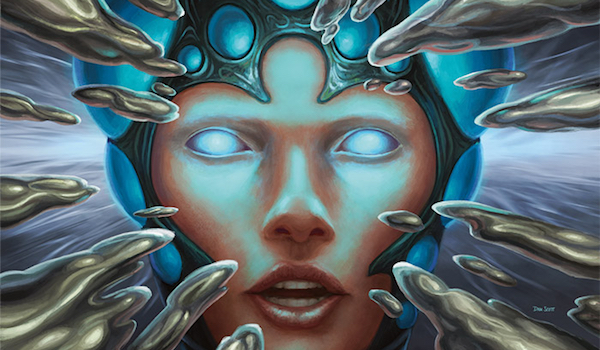
Bedlam Reveler promised to change that, though it took me a few weeks to get the hang of casting the Devil effectively. I’m still learning to play Monkey Grow with the new transformational sideboard, but Reveler has increasingly lived up to my expectations. Last weekend, my efforts culminated in a PPTQ win.
[wp_ad_camp_1]
The Deck
I played practically the same list as I did in my last few PPTQs, with the sideboard change of replacing Roast and Ancient Grudge with a pair of Spite of Mogis and swapping the Natural State for a second Destructive Revelry.
Monkey Grow, by Jordan Boisvert
The list performed very well for me and I think this build is optimized to address Modern's relatively unshifting top tier. Jund will always be a premier interactive deck; Infect, Affinity and Burn will forever sit at the top of the proverbial linear aggro heap; synergy-based aggro like Merfolk and Company decks will never truly disappear from the metagame. Monkey Grow can handle Modern’s swaths of linear decks with its mainboard and the format’s two reigning interactive decks, Jund and Jeskai Nahiri, with the Traverse-Reveler plan from the side. The deck's biggest weaknesses are still Chalice of the Void and Rest in Peace, neither of which sees much play.
I went 4-2 in another PPTQ after my last article, beating two Burn decks, Affinity and Jeskai Control and losing to Bant Eldrazi and Delirium Jund. After that event, my faith in the Reveler package began to waver. In hindsight, I can attribute the package’s initial failings in that and other events to two major factors:
- Oversiding. I brought in the Reveler package a little too often. Against Dredge and Infect, for example, we’d rather have Hooting Mandrills; until recently, I had been bringing in Bedlam Reveler.
- Recklessly taking damage. I acknowledged when I first introduced this build of Monkey Grow that interactive Lightning Bolt decks can opt out of out-grinding the Reveler plan by simply going under it. A series of burn spells to the face became the only way I would lose to Jund and Jeskai, grindy decks that can’t outlast the card advantage provided by chained Revelers. Of the two decks, Jeskai defeated me more often in testing, since it could more reliably act as a Burn deck. In this event, I was much more conservative with my life total on the Reveler plan. I played tapped lands instead of cantripping, paid mana for Gitaxian Probes, immediately killed enemy Snapcaster Mages, and Disrupting Shoaled early Lightning Helixes at my face. This modified play style paid off and I felt invincible against Jeskai in all three of my matches against it.
Report: PPTQ Dublin, GameKeeper Montreal, 9/10/16
For the second-to-last semi-local Modern PPTQ of the season, Montreal natives again came out in droves to race their linear decks against one another’s. My girlfriend Kelsey and I caught a ride with another player to Henri-Bourassa and settled in for six rounds of Bolt-slinging fun. Again, not a Mimic in sight.
Round 1: Jeskai Control (2-1, win roll)
Game 1
My opponent mulligans to six. I keep a hand full of green guys in the dark and cautiously play my lands without fetching until my opponent drops Celestial Colonnade. No longer fearing Blood Moon, I crack my fetches for shocks and play two Goyfs after a Serum Visions makes them Bolt-proof. In the meantime, my opponent suspends an Ancestral Vision, and draws three after taking a few hits from 2/3 Goyfs. I respond to his subsequent Supreme Verdict with two Snags to save my beaters. They die to Path-Snap-Path after I recast them, and Cryptic Command keeps Hooting Mandrills from resolving next turn. I lose to Snapcaster beats, one hit from Colonnade, and a pair of Bolts.
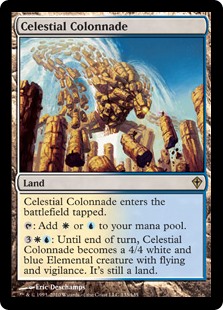 Sideboarding:
Sideboarding:
-4 Hooting Mandrills
-3 Thought Scour
-1 Mana Leak
-1 Stubborn Denial
+4 Traverse the Ulvenwald
+2 Bedlam Reveler
+3 Blood Moon
Game 2
My opponent goes to six again. I rush out a 0/1 Tarmogoyf to bait removal and cast Blood Moon on turn three. It works; Goyf eats a Path to Exile (wow!) and the Moon cuts my opponent off white. He resolves a Think Twice and I hard-Shoal the flashback, then hard-Shoal another Think Twice from his hand, stocking my graveyard for Bedlam Reveler. I make my land drops and cast Reveler with zero cards in hand, drawing two Goyfs and a Probe. The game ends a couple attacks later.
Sideboarding:
-2 Disrupting Shoal
+1 Mana Leak
+1 Stubborn Denial
I bring in more taxing counterspells for Shoals after having seen a Gideon Jura with Gitaxian Probe in Game 2.
Game 3
My opponent leads with Colonnade. I lead with Island, Serum Visions to set up the Blood Moon I opened, and fetch Forest to Traverse the Ulvenwald for a Mountain on the second turn after casting Probe for mana. Probe shows me Snapcaster Mage, Cryptic Command, Negate, Timely Reinforcements, Spinx's Revelation, and Steam Vents. Knowing he’s dead in the water to turn two Moon, my opponent holds up Negate in fear for a couple turns, giving me time to land a Delver and then a Snapcaster, flashing back Probe for life. He can’t take five forever, and eventually taps three of his four lands for Timely Reinforcements. I Bolt his face at end of turn and use the window to resolve Blood Moon. He can’t get through Shoal/Leak/Denial without white or blue and Delver kills him.
My opponent apparently boarded out Lightning Bolt against me, since he never saw Delver of Secrets until Game 3 and put me on some sort of Temur Midrange deck (a characterization which actually isn’t far off from my transformative “final form”). Once I learn this piece of information, I realize he never had a chance in the sided games.
Round 2: Burn (2-1, lose roll)
Game 1
I get turn one Probed and show Hooting Mandrills, two Bolts, Mana Leak, two Serum Visions, and a Wooded Foothills. Happily expecting Infect, I’m dismayed to see Scalding Tarn across the table, and even sadder to get Bolted on my end step after fetch-shocking to cast Serum Visions. I Bolt a Monastery Swiftspear and fetch Island to not take damage and cast Delver. I probably should have taken more damage and gotten a green source here, as Delver eats Searing Blaze and I can never cast Hooting Mandrills. I lose to a string of Spikes.
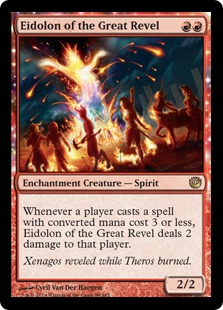 Sideboarding:
Sideboarding:
-1 Snapcaster Mage
-4 Gitaxian Probe
-2 Vapor Snag
-1 Thought Scour
+4 Traverse the Ulvenwald
+2 Blood Moon
Blood Moon comes in on the play to stop Path to Exile, Deflecting Palm, and to a lesser extent Lightning Helix, all cards that can wreck me post-board. Blanking Destructive Revelry (which now has a target, but still can’t be cast unless they are untapped when I cast the Moon) and Atarka's Command is another bonus.
Game 2
I land a turn two Goyf and a turn three Moon, cutting myself off green for the rest of the game. My whole hand is blue and red and I don’t draw another green card, so it works out. My opponent shoots me with Boros Charm after seeing the Moon on top with a Goblin Guide, which I kill with Lightning Bolt, and unfortunately doesn’t draw another multicolored spell so Moon ends up doing nothing but eating three mana. But Goyf backed up by Disrupting Shoal (pitching Delver to counter a Bolt and a hard-Shoal countering Goblin Guide) is enough to take it down.
Sideboarding:
-2 Blood Moon
+1 Snapcaster Mage
+1 Thought Scour
Game 3
I ship a slow hand and open a Mandrills, pitching Delver to Shoal to counter a one-drop even though I have Bolt. I play Scalding Tarn and pass, then crack, shock, and take two more to Bolt an Eidolon and put a third card in my graveyard. Mandrills comes down on turn two off a fetchland and is quickly removed by Path to Exile, which at least nets me a valuable third land. Some turns and Rift Bolts later, another Eidolon accidentally trades with my flashed-in Snapcaster Mage, and a third Eidolon then trades with a flipped Delver on defense. I hard-Shoal a Lava Spike to dump instant in the graveyard and turn on delirium, allowing me to Traverse for Mandrills, cast him for one, and hold up Mana Leak. I Leak Boros Charm and Shoal Swiftspear while attacking for four three turns in a row to take the game at 6 life.
This matchup is a lot better than I thought it was right after dropping the Huntmasters. Traverse the Ulvenwald helping with land drops makes a huge difference against Burn, and eight functional Tarmogoyfs plus Disrupting Shoal is still great against them. This match was the first time I’d cast Traverse with delirium while keeping in my Mandrills (a card combination I only ever have against Burn, since Lay of the Land is a card I want there), but it apparently can happen and is worth keeping in mind, especially with three Tarfire in the deck. That "oops, I hit delirium" did win me Game 3.
Round 3: Jeskai Queller Control (2-1, lose roll)
Game 1
I take some damage fetching, Probing, and dancing around the interactive hand of Leak, Spell Queller, Path, Desolate Lighthouse, Mountain, Glacial Fortress I see on my first turn. I Bolt one Queller to resolve a Tarmogoyf. A second Queller closes out a counter-war over Path to Exile, and I scoop at 12 life to my opponent’s board of Snapcaster and Queller when I have nothing substantial left in hand.
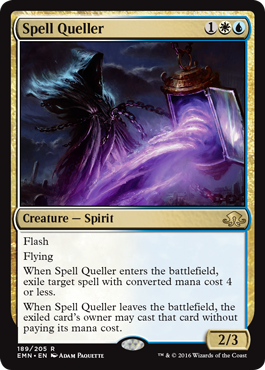 Sideboarding:
Sideboarding:
-4 Hooting Mandrills
-3 Thought Scour
-3 Stubborn Denial
-1 Mana Leak
+4 Traverse the Ulvenwald
+2 Bedlam Reveler
+3 Blood Moon
+2 Spite of Mogis
Spite of Mogis comes in over more Negate effects to kill Spell Queller (notably, Roast or Forked Bolt would have fallen short here, and Dismember would have paved the way for my opponent to beat me with burn spells). Leak can also deal with the 2/3 flier, so Stubborn Denial gets the axe entirely.
Game 2
Expecting my opponent to favor a grip full of removal, I keep a patient hand of Probe, Vapor Snag, and five lands. I pay mana for the Probe on turn one and see Visions, Snare, Leak, Bolt, Glacial Fortress, Hallowed Fountain, Mountain, Flooded Strand. We make land drops for awhile, and I draw a Blood Moon, which I don’t try to resolve. My Goyfs get countered and I soon seize a window to lock my opponent off white. We draw and pass for a while and I eventually start casting Bedlam Revelers. One gets double-Bolted and the second forces a scoop.
Game 3
I pay life for a turn-two Probe, seeing Remand, Mana Leak, Dispel, two Path to Exiles, and Lightning Bolt. My opponent has two nonbasic lands in play, and I have a Moon in hand, so I slam the Goyf and force him through the inevitable Remand with Shoal pitching Leak. Goyf gets Path to Exiled the following turn and my opponent fails to make a third land drop, so I cast Moon with my Forest from Path on turn three and put the game away with a Reveler some turns later.
While Bedlam Reveler is proving integral to my success against Modern’s interactive decks, it’s becoming increasingly clear to me that the real MVP in these matchups is Blood Moon. I’ve always felt the enchantment does more work against Jeskai than against Jund, but in reality, it’s just a stellar play against either when backed by constant pressure. Reveler ensures the threats keep coming, and Traverse works double-duty by fixing my own mana, making Moon better than it has ever been against Bolt decks.
Round 4: Dredge (0-2, lose roll)
Game 1
I Shoal a turn one Insolent Neonate, which buys me a ton of time, which I can't do much with thanks to a painfully slow hand. I tap out for Mandrills on turn three, but it’s not fast enough for my opponent, who jump-starts himself back in the game with a Faithless Looting after dredging Life from the Loam for two turns.
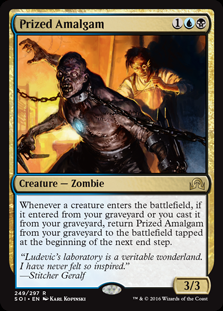 Sideboarding:
Sideboarding:
-2 Vapor Snag
+2 Destructive Revelry
Game 2
Instead of leading with Delver of Secrets, I hold up Stubborn Denial, hoping to snag Faithless Looting. My opponent punishes me for this play with Insolent Neonate, and I draw Disrupting Shoal the turn after it resolves.
I swing with a Mandrills a few times and he double blocks with Stinkweed Imp and Amalgam. I Tarfire the Imp two turns in a row. Three Amalgams grind me out, although my 5/6 Goyfs and a flipped Delver get close to closing the game. I Stubborn Denial a huge Conflagrate aimed at my head, but a timely pair of dredged Narcomoebas provide enough defense for my opponent to deliver a lethal counter-attack after blocking me.
I wasn’t happy with my sideboard plan in this match. I didn’t see Leyline of the Void at all from this opponent and am not sure Revelry deserves a spot in the 60 here. Vapor Snag would also have been good at multiple stages in the game to bounce an Amalgam or Stinkweed Imp. Leak is still good in this matchup, if mostly to counter dredged-up Stinkweed Imps, which Bolt effects are also good for.
The tension in my second game came from wondering when to hold up permission on the first turn and when to just slam threats. Since Denial only hits one enabler card, and the worst of the two, it might be better to never assume Faithless Looting is coming when I have something else to do. Our last game was a very close race; had I played the Delver turn one, I might have won it. These games demonstrate how useful Gitaxian Probe is against Dredge on the play.
Round 5: Burn (2-0, lose roll)
Game 1
I know my opponent is on Burn from scouting, and keep a hand with Hooting Mandrills. I Shoal his turn one Swiftspear, then Thought Scour myself in response to his turn two Eidolon. Mandrills comes down on turn two and easily races my opponent’s duo of Eidolons.
 Sideboarding:
Sideboarding:
-4 Gitaxian Probe
-2 Vapor Snag
+4 Traverse the Ulvenwald
+2 Pyroclasm
Game 2
I open two Goyfs, Traverse, Serum Visions and lands, and topdeck Tarfire for the turn one Swiftspear. My opponent fails to make a second land drop this game, and I play a 5/6 Goyf for each of the following turns (turn two Goyf, turn three Serum and Goyf, turn four Traverse with delirium and Goyf).
The whole match is over in eight minutes, giving me time to watch Kelsey unintentionally draw against her pair-down, who couldn’t ID into Top 8.
Round 6: (Intentional Draw)
Drew into the Top 8!
Top 8, Round 1: Counter-Cat (2-1, on the draw)
Kelsey and I play a lot at home and therefore know this matchup really well. She has been playing Counter-Cat for about a year and is undefeated today so takes the play when we are paired. Her list is the one I posted a few months ago, with these changes:
-1 Mutagenic Growth
-1 Remand
-1 Gitaxian Probe
-1 Huntmaster of the Fells (SB)
+1 Hooting Mandrills
+1 Spell Snare
+1 Mana Leak
+1 Lightning Helix (SB)
Game 1
My opponent leads with a Delver, which I Tarfire. We both follow up with Tarmogoyfs. Kelsey Paths mine and I Shoal, then kill hers with an attack and a Lightning Bolt. Snap-Path successfully removes my Goyf and I resolve a Mandrills. She drops two Nacatls and her own Mandrills, which trades with mine when I attack. I land another one and we continue racing. At 5 life, she turns her team sideways to deter me from attacking, since she’d have lethal next turn. But I have Lightning Bolt in hand and get to crash in with Mandrills for lethal.
 Sideboarding:
Sideboarding:
-4 Hooting Mandrills
-3 Thought Scour
-2 Disrupting Shoal
-3 Mana Leak
-3 Stubborn Denial
+ All 15
We found during testing that I had to bring in Revelry in this matchup, or I would auto-lose to a turn two Isochron Scepter with Path or Helix imprinted. Counter-Cat also brings in Revelry for Blood Moon.
Game 2
Probe shows me two Bolts, Destructive Revelry, Forest, Mutagenic Growth, and Wild Nacatl. Kelsey accidentally fetches Island instead of Steam Vents to get around Moon, immediately realizing after I cut her deck that she needed a red source to compliment Temple Garden and cast her Bolts.
She Grows her turn one Cat in response to my main phase Tarfire, and soon lands a total of three Nacatls and a Delver. My lone Tarmogoyf plays defense, but when she lands one of her own, I'm forced into action. I almost tap out for a slow Bedlam Reveler. Goyf gets Pathed, and Reveler blocks a 2/2 Nacatl. I tap my final land to Tarfire the flipped Delver and take five from Tarmogoyf.
The Reveler drew me into Snapcaster Mage and Vapor Snag, which will buy me another turn against Kelsey’s offensive and allow me to make an attack with the Reveler. It hits for six and brings Kelsey to 4. At 2 life, I’m still dead to a topdecked red source, which she doesn’t draw. But Path to Exile removes Snapcaster and I lose to tiny Nacatls.
Sideboarding:
-2 Destructive Revelry
+2 Disrupting Shoal
I sometimes board out my Revelries in this matchup since Kelsey expects them and will hopefully pace her Scepters anyway, but I still lose to turn two Scepters with this plan if she goes for them. Luckily, she never draws the artifact.
Game 3
Probe shows me two Mutagenic Growths, Tarmogoyf, Bolt, Path, Arid Mesa, and Scalding Tarn, meaning Kelsey can’t fetch Forest to get around Blood Moon. She plays a turn two Tarmogoyf with an Island and double-Growths her Delver after I Bolt it. Tarfire finishes the Human Wizard off before it can transform.
I resolve the Moon on-curve. Goyf hits me and I respond with a topdecked Goyf of my own and a Bedlam Reveler. I double-block her Goyf and a Snap-Bolt kills mine, but another Goyf and a Delver of Secrets from my Reveler draws close out the game before she finds Forest to pop the Moon and cast her Paths and Huntmaster.
As hopefully evidenced by this match report, Counter-Cat vs. Monkey Grow is a hugely dynamic matchup with a ton of role-shifting and game state analysis. It's too bad Kelsey and I couldn't have met in the finals instead, but I'm glad the one Tarmogoyf deck I did get to face at this event was of my own making.
Top 8, Round 2: Jeskai Queller Control (2-1, on the play)
I’m again paired with Norman Fried, who hasn’t lost a match since I beat him in Round 3.
Game 1
I open with a Delver that doesn’t instantly eat Lightning Bolt, leading me to put my opponent on Lightning Helix. I fetch for Island, Serum with a blue up to Deny the instant, attack, and pass. Sure enough, Helix comes down on Norman’s main phase, and I counter it. Delver flips and cracks in uncontested for a couple of turns, and when my opponent’s at 5 life, he goes for Snapcaster-Helix. I respond to the near-tap out with Tarfire and Lightning Bolt to the face for lethal. Not a Dispel in sight!
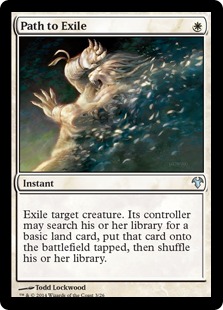 Sideboarding:
Sideboarding:
-4 Hooting Mandrills
-3 Thought Scour
-3 Stubborn Denial
-1 Mana Leak
+4 Traverse the Ulvenwald
+2 Bedlam Reveler
+3 Blood Moon
+2 Spite of Mogis
Game 2
I keep an intentionally slow hand and hard-Shoal a pair of Helixes at my face in the early-game. Eventually I cast two Revelers. The first gets Pathed, and the second comes down with a Delver. That play opens me to Supreme Verdict, and I fail to find another threat or a Blood Moon and lose to three hits from a Colonnade and a burn spell.
Game 3
Norman mulligans to six, and I open Bedlam Reveler, Serum, lands, and two Traverses. We both cantrip for a few turns, although I more than he. I Shoal a pair of Lightning Helixes aimed at my face. My Snap-Serum resolves and then eats a Bolt, giving me delirium to search up and resolve Tarmogoyf through a pair of Spell Quellers. I use Bolt and Spite to kill the Spirits, and end up never needing the Reveler, which sits patiently in my hand with Blood Moon and a third Disrupting Shoal in tow should things turn sour. My opponent can’t answer a pair of Goyfs.
I like the idea of Spell Queller in Jeskai, but I don't think it's great against interactive decks. While the Spirit should give control shells more game against Modern's linear decks, I think it might need a relegation to the sideboard versus Lightning Bolt.
Top 8, Round 3: Abzan Vial (2-0, on the play)
Kevin Tran is playing a value-packed Flickerwisp deck in Abzan colors, with Aether Vial and Collected Company. He’d lost to Kelsey in the Swiss and didn’t seem too excited to stare down more Goyfs and Pyroclasms.
Game 1
I keep a hand with two Serum Visions, Bolt, Leak, and lands. Serum scrys a Goyf to the top, and Kevin leads with Noble Hiearch. I draw and pass, deciding to leave the Hierarch on the board for a turn so I can Leak a spell and then kill it and cast Goyf on the same turn. I Leak a Tidehollow Sculler (meh) and Kevin plays a second Hierarch with his third mana source. Bolt and Goyf resolve as planned, and my opponent makes his third and final land drop of the game. He also plays a third Hierarch and Voice of Resurgence.
I swing with the Goyf, who isn’t blocked, and Snap-Bolt one of the dorks. Wanting to leave Voice up to block Goyf this time around, Kevin attacks with Hierarch and immediately realizes his mistake. I block with Snapcaster Mage, further crimping his mana development. My attacks keep coming, supported by a Mana Leak, a Hooting Mandrills, and Shoal on a Path.
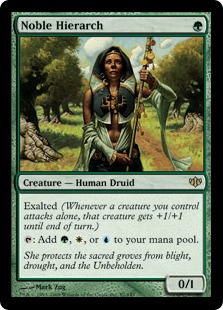 Sideboarding:
Sideboarding:
-4 Hooting Mandrills
-3 Thought Scour
-4 Disrupting Shoal
-3 Stubborn Denial
-1 Mana Leak
+ All 15
Game 2
Kevin mulligans to five this game, and neglects to play a spell on turn one. I fetch an Island to open with Delver of Secrets, which blind-flips. My opponent makes a land drop and plays Voice of Resurgence, and I Probe and fetch for Forest to Traverse for Mountain, planning to cast Blood Moon next turn. Probe shows me Flickerwisp, another Voice, and Gavony Township. Kevin plays the Township and decides on the Voice. Moon cuts him off green and double white, and Delver races the two Voices with some help from a few burn spells and two Goyfs.
"Monkey Grow"
This tournament displayed Modern Temur Delver at its purest: an aggressive Bolt/Goyf deck that leverages Blood Moon to punish the format's famously greedy mana. Blood Moon is an incredibly powerful tempo card in Modern, and shells that reliably follow up with heaps of pressure use it better than others.
In my article last week, I attributed the success of Modern's top decks to three key components. Between its efficient threats, flexible disruption, and bountiful cantrip suite, Monkey Grow is highly proactive, interactive, and consistent. Bedlam Reveler covers for the deck's main weakness by providing an alternate gameplan against removal-heavy decks. Now that I've learned to take damage conservatively on the Reveler plan, I'm very excited to see where this deck can go in an increasingly linear Modern format. As always, expect a 3,000-word postcard!





Something went seriously wrong in formatting or copy/pasting in your Round 2 story. FYI.
Also, congrats!
Was a messed up tag. Fixed!
Looks like your blurb for the Burn matchup needs a bit of editing. That said, I do want to congratulate you on your success, and thanks for what seems to be a really finely honed list at this point. Looking forward to seeing more of it in your subsequent articles – I know that some of your Magic theory and brewing articles are very good, but any time Monkey Grow touches down at a tournament, I want to hear about it.
Good report. Looks like Grow is healthy as ever. How do you deal with the explosiveness of Affinity?
In Game 1 we try to race them (which is tough), and in Game 2 we grind them out (which is easy). Bring in Revelers. Great matchup.
I really like your list but unfortunately cannot afford goyfs.
Is there any way to run the monkey grow list without goyf?
perhaps bUG and play Tasigur/Grim Flayer?
thank you
I’ll respond for Jordan: Nope.
Goyf is too efficient to omit. That being said, you can always replace it with a cheaper alternative, but you will lose far more match-ups.
Yay monkey grow! Congrats Jordan!
I was also stoked to hear how well counter cat did at the tournament. Congrats again to you and your gf for top 8ing together.
Are there any changes you are planning to make to Temur after the tournament?
Are there any changes she is making to Counter Cat after the tournament?
We’re actually both really happy with our lists right now.
How do you make the Monkey Grow? I don’t get it. Why don’t you just call this Temur Delver so that people know what you are talking about? Deck names should be informative so that people don’t have to ask what it is if they are familiar to the format.
“What deck are you playing?”
“Monkey Grow.”
“What is that?”
“Basically just Temur Delver but I can counter spells that cost one or two for “free” with Disrupting Shoal and I play Hooting Mandrills.”
By calling this Monkey Grow, your article is click bait. People click to see wtf is that. Then they feel betrayed because it’s not something new and exciting, it’s Todd Anderson’s Temur Delver but with Disrupting Shoal. I shouldn’t have to click on the article to figure that out.
Dear Corbin,
Come on Corbin. You are here now. Fix this. Make this website a little more useful. Would WOTC or SCG call this deck Monkey Grow? Would they call your favorite deck Fish Sticks? No! They call it a useful informative name.
Thanks,
A Concerned Reader
Editor in Chief here. Your criticism is duly noted. One of our current projects here is to come up with a standardized naming convention for all Modern decks. This will affect our Monthly Metagame Reports, but also titles of articles and basically every other way we refer to a deck. Apologies if you felt misled by the title.
For what it’s worth, the progenitor of this deck was called “miracle gro” and ran quirion dryad. This was a very well known deck for a long time and is a legendary piece of magic history, but it’s understandable that newer players wouldn’t be familiar with the name.
It’s always the case that decks get “nickname” nomenclature, but that’s fine! Decks like solar flare, tin fins and boat brew are the stuff of legend.
Don’t fall into the trap of naming all decks “colour: flagship spell” because it’s boring! We need those classic nicknames to make modern a vibrant format.
But if you must make a concession to this, give decks a title;subtitle format such as rug midrange;monkey grow
Sorry I probably went a little over board. I didn’t mean to be so harsh. I apologize for that. It is good writing, and the click bait thing was a little excessive. This response was great though. Fantastic customer service. Someone commented saying that giving it a title like “Temur Dever; Monkey Grow” might be more appropriate for the article names. I like that idea a lot. It gives the author room to brand his personal flavor of the build that is a part of a broader archetype. You guys are great. I was an occasional visitor, I will be here much more now. Thanks guys.
Just chiming in to agree with the sentiment. I like the deck (and the sultai version) but really dislike cute and unnecessary names. To the extent grow is a legit deck name id think it applies to things that get bigger over time – quirion dryad, vinelasher kudzu or some heroic cards. Goyf fits but that alone cant seriously be more relevant than the rest of the deck which is temur delver (delver and lots of instants and sorceries).
“Grow” is an archetype that became popular in the late 90s which originally used Quirion Dryad, but can refer to any green-based tempo deck with creatures that grow (with Tarmogoyf favored over the Dryad in recent lists), and “Monkey” refers to Hooting Mandrills which are a key part of the tempo plan with Stubborn Denial. Jordan has been playing, tweaking, and winning with this deck long before Todd Anderson T8’ed with his version. Calling this article clickbait just because you don’t like the name of the deck is pretty laughable. Rage more?
Gonna try to clear the air here and clarify a few things. First of all, you are all correct about the history of the “grow” moniker. I’m an old player myself (started around Revised), so I’m familiar with these old deck names and I agree they add character and color to the game. That said, most players are not in my camp, and Modern Nexus (along with most sites) aims to educate and provide resources for new players as well.
As for Temur Delver, it is an established archetype, and Jordan’s is just one build. Not all of them run Hooting Mandrills. While I’m loathe to prevent Jordan from using his own name for an archetype he’s helped develop, I also want his articles to be intelligible and clear. It gets pretty confusing when a deck that’s only one or two maindeck cards off suddenly acquires a new name.
So I hope you’ll understand if we as a content producer shy away from the more esoteric names that require background knowledge. Modern (and Magic) has enough barriers to entry for the new player already.
Im not sure how many readers this blog has to have to take one reader’s comments so seriously. Grow is an archetype, and if some people get confused by words outside of their general vocabulary, then its their problem. Ive seen Monkey Grow used dozens of times in articles here in the past year, this is the first time one person complained. Dont need to have knee-jerk reactions here. Its competitive Magic, serious players will understand the intricacies of archetypes, and sub-archetypes. My three cents.
Addressing the issue of Modern deck names (which I think are a mess in general) in a future piece. Stay tuned!
Dont give in! Monkey Grow is a great deck name :p We dont name cars Black Family Sports Sedan, or White Electric Subcompact.
Congratz!
When is the RPTQ linked to the PPTQ
Also are there any large modern events coming up that you plan to attend, would love to see the deck on camera
Congratz! I’m glad your commitment and hard work on this archetype paid off.
Thanks for the detailed report. It’s cool that you have matchups, where you bring in all 15 cards. It’s quite unique, and I believe it makes life much harder for your opponents, since your deck changes really much after sb. Good job!
Congratulations on the win! I managed to luck dog a smaller PPTQ in Burlington, VT (only 15 people) so I’ll be heading to Verdun (Montreal) December 11 for the RPTQ. Judging from your report, it sounds like you might be at that one too! I hope to test my mettle against your deck! A friend of mine says that Montreal is known for affinity. Do you have any meta advice for the RPTQ to a relatively new player that got lucky? Are there any events leading up to it that I should go to to scout the other decks?
Just prepare for Modern’s best strategies and you’ll be fine. I’ve generally found competitive events here and elsewhere to reflect with surprising accuracy what I see on MN’s Top Decks page. For what it’s worth, I play in 2-3 local events weekly and haven’t seen that much Affinity lately. Chord, on the other hand…
Congrats on the finish. I’ve been running a pretty similar list leaving out the Shoals for a few other removal spells. One thing I’ve found super helpful for the grave hate and Chalice of the Void out of the side is Seal of Primordium. The 2 mana isn’t ideal but having a spell down to “cast” for free later if the Chalice/Rest in Peace come out has been a game saver several times, especially against the Eldrazi decks. Feeding Tarmogoyf in a different way has been a nice added bonus too. I enjoy the articles and reports, keep up the great work!
The main draw to Seal in my opinion is that it can be cast pre-emptively, such as before resolving Reveler and being forced to dump it. I don’t like that it’s not an instant/sorcery for Delver and doesn’t deal damage.
A major strike against Seal is that it doesn’t open opponents up to surprise tempo swings. I’ve had players slam haymakers like Batterskull or Vedalken Shackles plus activation against me and then get blown out by a two-mana spell trading for their five-mana investment.
In my many kitchen table matches against Counter-Cat, drawing Revelry and losing it after being forced into a position where I need to cast the Reveler, and then losing to Scepter, really stinks. Granted, Counter-Cat isn’t a deck I’d expect to face at an actual Modern event, but this kind of scenario can come up against other decks too.
Ancient Grudge would flash back after hitting the grave, but it doesn’t also hit Rest in Peace, and we only have two slots in the sideboard to disrupt artifacts/enchantments. Seal addresses this issue and I’m planning to try out a pair soon over the Revelries. It’s also possible that a split is correct.
Congratulations! I’m glad to see delver decks picking up steam in Modern– we need more tempo decks :). Hoping you make it to the top! How were the Spites?
They were great every time I drew them. I love this 75 going forward.
How do you feel about this deck compared to Grixis Delver? I’m leaning towards picking one of these two as my modern deck.
Thank-you so much for such a long, dedicated body of work. I find myself very clearly in Temur Aggro in Modern…ranging from budget Delver/Mandrills lists to Deleirum Revelers/traverse lists to Prowess builts…all various combinations of 16 creature Temur builds…and your work here helps me understand the meta so much more without having to go through it even if our builds differ significantly…I’ve recently got 4 Snapcasters now…which is funny as I sometimes wish my deck was more budget with Delvers and Mandrills sometimes…still just wanted to say thanks I”m looking forward to reading more of your reports they are exactly the perspective and angle on the game that I enjoy playing and learning to how to improve on…the lesson to stick with a deck and learn the format is very apt
Seeing this late, but thanks for the line! Glad I helped